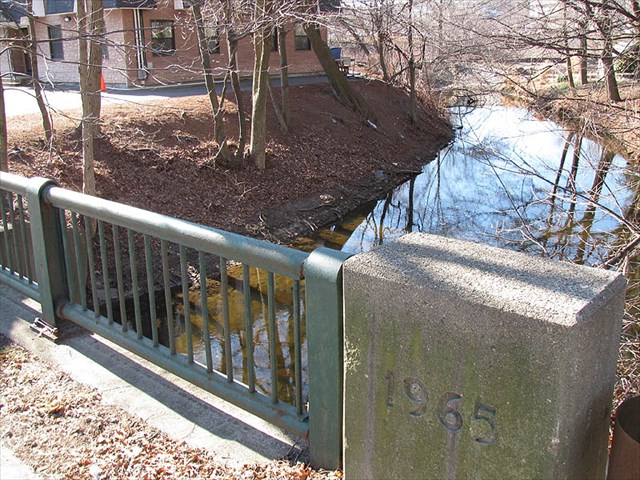This is a view from the
Crispus Attucks Footbridge in
Framingham, built near the area where he was reportedly born and worked for
William Brown. And it looks like a good place to pause and reflect about how to reconcile the conflicting traditions about Attucks’s life.
The standard modern story (which I’ve repeated myself) is that Attucks escaped from
slavery in Framingham in 1750, when he was about twenty-seven years old, and made a new life for himself as a sailor traveling to the
Caribbean and North Carolina. At least while he was back in Boston, he used the alias “Michael Johnson,” presumably to preserve his freedom; that was how he was identified immediately after he was killed. We don’t know how within three days
printers knew he was “born in Framingham,” nor how his real name became known the next week.
The Brown family traditions don’t fit easily with that story, but they aren’t easy to dismiss, eoither. Descendants of William Brown told their story of his slave Crispus by 1857. We might suspect they were trying to seize on the celebrity that abolitionists like William C. Nell had conferred on Attucks, but in 1859 antiquarians found the
Boston Gazette advertisement that backs up the family’s claim.
Brown descendants also brought forward a cup, teapot, and powderhorn that Attucks reportedly owned. The provenance of these “relics” is impossible to confirm, but the two items that survive do appear to date from the early 1700s. They’re also cheap and misshapen, unlikely to have been saved unless the family had invested them with some meaning.
The biggest contradiction between those two stories is that the Brown family said Attucks returned to his master after 1750 and remained in Framingham for the rest of his life. In the late 1800s, that tradition expanded to say that Brown also let Attucks go to sea, apparently to accommodate the documentary evidence from 1770. But there’s still no explanation why Attucks would be using the name “Michael Johnson” if he had his master’s permission to travel to Boston, trade
cattle, and work on
ships.
One possibility is that in the confusion after the
Boston Massacre people misidentified the big mulatto man shot in the chest as the sailor Michael Johnson. William Brown alerted the authorities to their mistake. and they corrected the dead man’s name to Crispus Attucks in legal papers by the next week, but the printers didn’t catch up, leaving us with newspapers that still erroneously called that man a sailor.
This scenario raises more questions:
- Why did the first reports about “Johnson” already connect him to Framingham?
- Why did Boston bury Attucks as a “stranger” if he had a master and family still in close touch and living less than a day away?
- Why didn’t William Brown seek compensation from the Crown for the loss of his slave?
- Why did Bostonians like William Pierce (cited in Traits of the Tea Party) continue to say Attucks was a sailor for years afterward?
Another possibility is that the Brown family preserved the memories of Crispus Attucks working for their ancestor, trading cattle “on his own judgment,” but forgot the part about how he escaped and never came back. That may not have been his 1750 departure; Attucks may have returned then but left permanently later, and Brown didn’t bother advertising for him again. Other members of the extended Attucks family continued to work in Framingham for years, and the family could have attached memories of them to Crispus after he became famous.
Again, that scenario has a big hole:
- If one of your family slaves has run away and you later learn he’s been killed in a riot in Boston, wouldn’t you remember him as a miscreant who got what was coming? Why would your family memory drop the fact that he’d run away when to you that was probably one of the most significant facts about his life?
Finally, there’s the
Natick tradition that
William C. Nell spoke about in 1860, one which named other members of the Attucks family. Nell’s informant said that his or her mother had heard Attucks’s sister Sal speak about him, apparently in the 1770s or 1780s. Nell didn’t name his source, and his papers have probably disappeared, leaving us with less to evaluate. To my knowledge that tradition never got into books, and no historians have grappled with it.
The Natick information emphasized Attucks as a big man, a bold man, and a law-breaker (smuggling horses, fighting
soldiers). It said nothing about Attucks being enslaved to the Brown family, though it did identify him as a likely son of Jacob Peterattuck, “who lived with Capt.
Thomas Buckminster of Framingham.” That tradition also said nothing about Attucks’s work at sea, saying instead that he had visited home “with three or four horses” shortly before the Massacre. Again, that’s hard to reconcile with the 1770 reports about “Michael Johnson” awaiting work on a ship south.
A lot of recent historical scholarship has used Crispus Attucks as an example of a politically aware sailor, not so much tied to Boston as part of a roving maritime working class within the British Empire. It emphasizes his life in the shadows as a runaway slave.
However, if the Brown family and Natick traditions are correct, then Attucks had much stronger links to life in rural Massachusetts than the standard profile suggests, though he may also have worked on ships. If not legally free, Attucks had at least some practical freedom within his bondage to William Brown. And he had an extended family out in the Framingham and Natick area, some of them known for carrying on Native American traditions (“the gourd-shell squaw”). That would provide new areas for historical consideration. But still, how did “Michael Johnson” enter that scenario?






